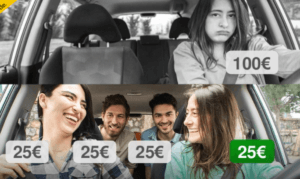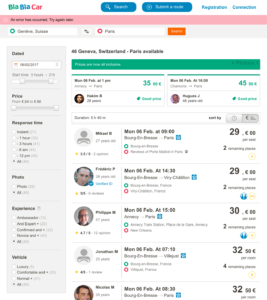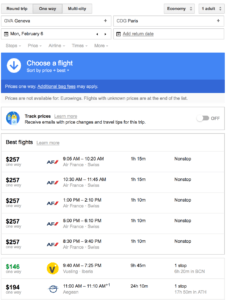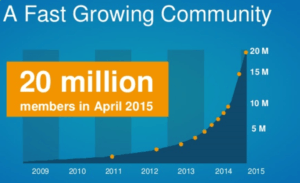BlaBlaCar – Disrupting road travel by Trusted carpooling

BlaBlaCar – the RyanAir of Road – has built a community of 40 million users around trustworthy carpooling. Born in Paris and already proved its worth in Europe, BlaBlaCar is now expanding to emerging markets as it provides last minute travel options and cost savings for both riders and passengers. This blog highlights how BlaBlaCar has disrupted road travel.
BlaBlaCar has disrupted the road travel! Let’s see how.
One of the companies to enter the list of Unicorns, BlaBlaCar is the world’s largest long-distance ridesharing community. With 40 million members, BlaBlaCar connects riders and passengers for trustworthy inter-city travel and share the cost of the journey.
Conceived as an idea in 2004 by a guy stuck in Paris with no way to get to home to his family, BlaBlaCar was first launched in Sep 2006. In the last decade, it has raised over $310M and is currently valued at $1.5B. Initially launched in Paris and expanded in Europe, BlaBlaCar has recently expanded to other continents as well. India, Brazil, Turkey are just a few countries among the emerging markets BlaBlaCar is trying to capture.
How does BlaBlaCar create value?
Essentially, BlaBlaCar is a marketplace that connects riders with empty seats with passengers looking for inexpensive travel especially at the last minute.
Riders (drivers) are, in any case, paying for the cost of the gas and toll expenses. BlaBlaCar helps reduce the cost of their travel. It has been estimated that BlaBlaCar is helping riders save north of $250M per year.
Figure: Value proposition to riders
For passengers, at approx. $25 for a 200-mile ride, it offers an inexpensive travel option as compared to flights / trains which are pretty expensive, especially when booked at the last minute.
For example, consider a trip from Geneva (Switzerland) to Paris (France). BlaBlaCar offers a price which is ~2.5x cheaper than that of train and 4.0x cheaper than flight, as depicted in the figures below. This provides a great option for passengers planning their trip at the last minute.
Figure: Comparison of Geneva-Paris travel fare by BlaBlaCar, flight and train
Apart from savings, BlaBlaCar rides offer a great social experience (as compared to riding / traveling alone). It also offers transparency and predictability on prices (as compared to other cab options like Uber). BlaBlaCar also helps contribute to the environment by increasing the average car occupancy from 1.7 to 2.8 and thereby reducing traffic and emission levels. Since the rider does not have any other benefits other than cost savings, it ensures the element of trust in the system, which is further strengthened by two-way reviews and ratings.
Here’s what customers say about BlaBlaCar:
How does BlaBlaCar capture value?
Like Airbnb and Uber, BlaBlaCar takes a small commission (15-20 percent) on every ride. Very simple, but very important in the growth of a startup. With upfront collection of fare from passengers, BlaBlaCar should have negative asset intensity contributing to higher cash flows. While the actual financials of the company are unknown, it has been estimated to be making $75-100 annually in revenues.
BlaBlaCar enjoys significant network effect. The more people use it, the more rides one will find. People often ask, who is BlaBlaCar competing against. It more directly competes with regional bus lines and trains rather than taxis or other intra-city car-sharing services such as Uber, Lyft. Hence, it has been able to strengthen its position in the market as the most trustworthy carpooling service.
How does BlaBlaCar work?
A driver who is driving from one city to another and has empty seat(s) in her car can post in on BlaBlaCar’s platform. The driver can also include the intermittent cities in the journey thereby expanding the pool of interested passengers.
Similarly, a passenger can look for a seat in advance and book it. BlaBlaCar shows results with pricing and timings. The results can be filtered by price, time of the day, type of car, response rate, etc. If interested, a passenger can directly reach out to the rider and asks questions (if any). Once the rider approves, passenger makes the payment in advance of the journey. After the journey is complete, BlaBlaCar transfers money to the rider after deducting its commission. Both riders and passengers rate each other, which helps inform the search results for the next set of bookings.
Here’s a video showing how it works:
I personally have used BlaBlaCar several times in Europe and have really enjoyed riding with strangers and making new friends, in addition to saving a few bucks.
BlaBlaCar’s growth: What’s next?
Figure: Growth of BlaBlaCar
Figure: Current geographical reach of BlaBlaCar
BlaBlaCar – ‘RyanAir for road’ – has grown at a marvelously amazing rate in last few years. It has expanded to over 19 countries in the last decade without running into regulatory issues in most markets. While BlaBlaCar rules over European market and is on its way to capture emerging markets, the co-founders are often asked about their plans to enter United States. Let’s wait and watch how they expand their victory from just Europe to the entire world.
Sources:
https://en.wikipedia.org/wiki/BlaBlaCar
http://fortune.com/2015/09/16/blablacar-unicorn-list/
http://www.slideshare.net/vaninaschick/europas-blablacar
http://www.businessinsider.com/how-much-money-blablacar-could-be-making-2015-9
http://www.wired.co.uk/article/blablacar
http://pt.slideshare.net/NOAHAdvisors/blablacar-noah15-berlin/18










Mohit – how does BlaBla car ensures the safety of the passengers during the ride or does it absolve itself of any responsibility?
Sidharth – It’s a great point you raise. I actually myself thought about it the first time I used BlaBlaCar. But BlaBlaCar has put in really good system to ensure safety. Every user has to use real name and photo, and passengers can select which rider to ride with and vice-versa. BlaBlaCar also verifies everyone’s phone numbers and emails. They also encourage you to link your facebook account with BlaBlaCar profile.
Next, one can look for the ratings and reviews of the folks on the other side. That, to my mind, is the most effective way of ensuring safety.
Interesting concept – it seems BlaBlaCar and Uber are on a collision course here, with BlaBla eventually moving into urban carpooling or Uber moving into intercity carpooling/travel. Do you get a sense that competition between the two services is heating up in BlaBlaCar’s markets? I wonder if Uber will roll out a similar service in the US in anticipation of market entry by BlaBlaCar…
Andrew – Thanks for your comment and for raising this interesting question.
I have been myself surprised as to why BlaBlaCar hasn’t expanded yet in the United States. I think it’s to do with long distance inter-city rides in US unlike in Europe. The average inter-city ride in Europe is ~200-250 miles. Also, the gas in US is much cheaper in US so the cost of the trip is already lower for the rider.
In terms of Uber’s response, I will be curious to see if they enter this market. My sense is they won’t. I see Uber now becoming more of a logistics company (transporting passengers and delivering goods) while BlaBlaCar’s Customer Value Proposition to drivers is to lower the cost of travel, and not use that as a means of living. Also, the customer target segment is very different – these drivers are not professional drivers but indeed the other set of customers looking to offer rides to others and save a few dollars (and not earn profit). This is why Uber and BlaBlaCar haven’t really competed yet. BlaBlaCar is actually an Amtrak/Eurail alternative, not a taxi alternative.
Nice post Mohit. To add to Siddharths point regarding safety, I think it maybe fine in more developed countries but as I understand the company is trying to expand in emerging markets such as India and Brazil where safety is a much bigger concern. Given that fake Facebook accounts and email addresses can be obtained, does Bla bla car need to have a more exhaustive process to verify drivers before they sign on in these countries? I also feel since the rides via Bla bla are significantly longer than in Uber, just relying on the ratings of the driver may not be enough to give customers, especially women, confidence to ride with strangers.
Also what is their policy regarding insurance in case an accident happens on the ride? I would imagine this is left for the driver and rider to figure out between themselves?
Thanks
Rahul – I agree. Things are much less safer in emerging countries like India and China. As I was reading through BlaBlaCar India’s webpage (https://www.blablacar.in/trust-safety-insurance), they indeed are trying to build the community on the basis of trust. However, things are not that simple. There always will be a risk of safety, and it’s true from all people in the car – driver, passenger, co-passenger. As you would know, Uber also has had a few unfortunate incidents, mainly with women, in India. I don’t think BlaBlaCar has put in enough mechanisms in place to tackle this. In fact as I was writing this response, just found a new of a complaint by a BlaBlaCar passenger against the co-passenger.
They will definitely need to work around this if they want to remain competitive and scale up fast in emerging markets.
Thanks for the post Mohit. I always wondered if it would be possible to execute this type of business model successfully and it seems like this company has done so. Aside from the more obvious safety concerns, is there any additional risk with regards to insurance policies. I am not sure if drivers will have to add more expensive coverages if they effectively commercialize their service. Any thoughts?
Very good question.
And the simple answer is that BlaBlaCar carpooling does NOT impact insurance at all.
The driver’s existing car insurance covers carpooling. Here’s what BlaBlaCar website says: “When you travel with BlaBlaCar as a driver, passengers contribute towards your running costs. No profits are made which is why BlaBlaCar drivers’ insurance policies are not affected.”
No additional insurance is needed for the passenger other than the mandatory insurance (Third Party Liability) of the driver. In case of any accident, all passengers will be covered by the driver’s mandatory TPL.
Thanks Mohit for this great post. I have a lot of friends who have used BlaBlaCar and they love it – it’s impressive how much their prices are cheaper. I have always wondered why there were no BlaBlaCar competitors here in the United States. I assume this has certainly something to do with the density of large cities in Europe – the average distance traveled in the U.S. is too long, leading people to prefer flying?